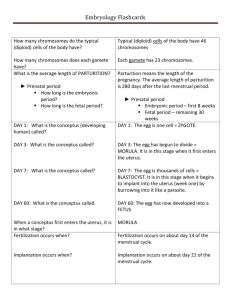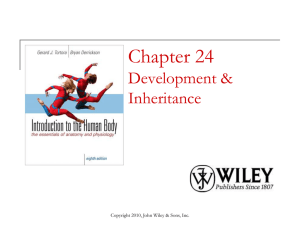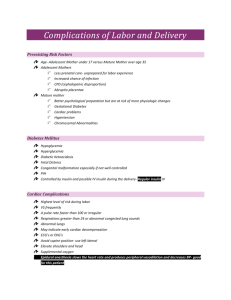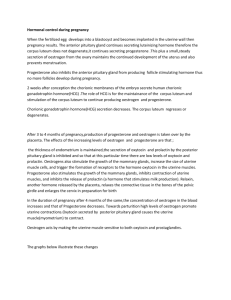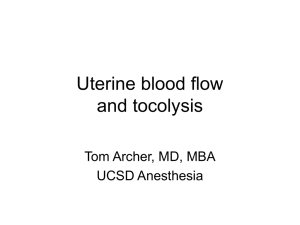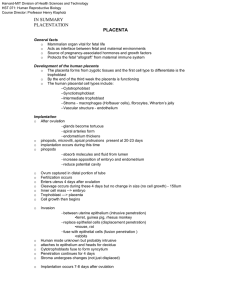Embryology and Development
advertisement
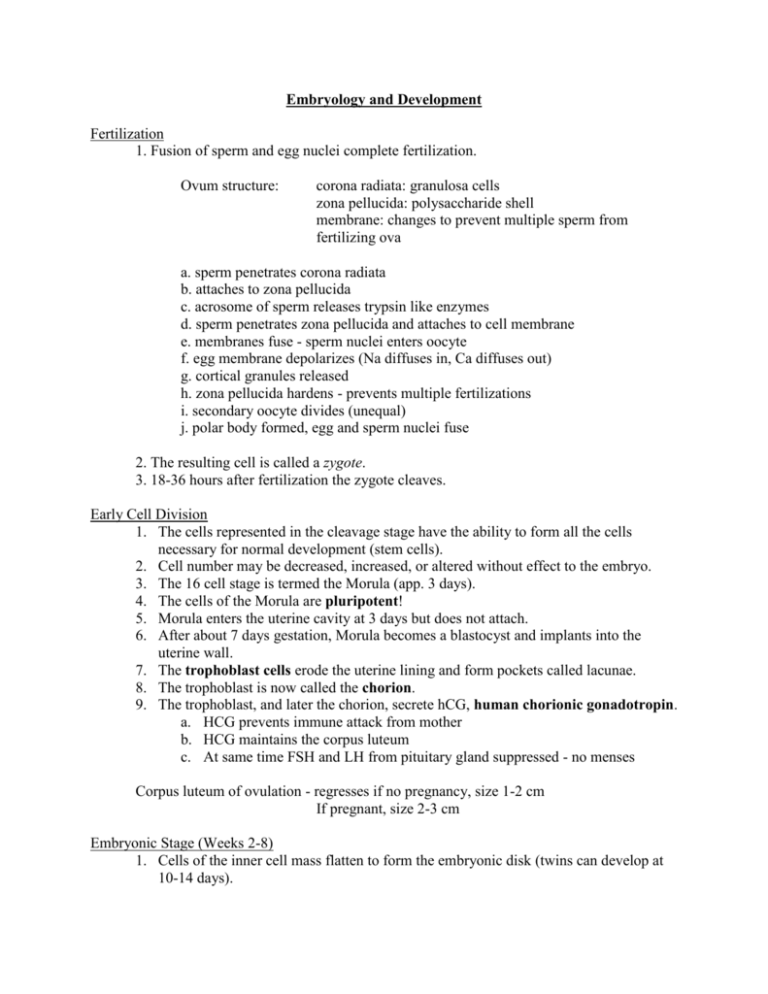
Embryology and Development Fertilization 1. Fusion of sperm and egg nuclei complete fertilization. Ovum structure: corona radiata: granulosa cells zona pellucida: polysaccharide shell membrane: changes to prevent multiple sperm from fertilizing ova a. sperm penetrates corona radiata b. attaches to zona pellucida c. acrosome of sperm releases trypsin like enzymes d. sperm penetrates zona pellucida and attaches to cell membrane e. membranes fuse - sperm nuclei enters oocyte f. egg membrane depolarizes (Na diffuses in, Ca diffuses out) g. cortical granules released h. zona pellucida hardens - prevents multiple fertilizations i. secondary oocyte divides (unequal) j. polar body formed, egg and sperm nuclei fuse 2. The resulting cell is called a zygote. 3. 18-36 hours after fertilization the zygote cleaves. Early Cell Division 1. The cells represented in the cleavage stage have the ability to form all the cells necessary for normal development (stem cells). 2. Cell number may be decreased, increased, or altered without effect to the embryo. 3. The 16 cell stage is termed the Morula (app. 3 days). 4. The cells of the Morula are pluripotent! 5. Morula enters the uterine cavity at 3 days but does not attach. 6. After about 7 days gestation, Morula becomes a blastocyst and implants into the uterine wall. 7. The trophoblast cells erode the uterine lining and form pockets called lacunae. 8. The trophoblast is now called the chorion. 9. The trophoblast, and later the chorion, secrete hCG, human chorionic gonadotropin. a. HCG prevents immune attack from mother b. HCG maintains the corpus luteum c. At same time FSH and LH from pituitary gland suppressed - no menses Corpus luteum of ovulation - regresses if no pregnancy, size 1-2 cm If pregnant, size 2-3 cm Embryonic Stage (Weeks 2-8) 1. Cells of the inner cell mass flatten to form the embryonic disk (twins can develop at 10-14 days). 2. 3. 4. 5. 6. An outer ectoderm and inner endoderm is formed. Later the third layer, the mesoderm, is produced. These three layers form the primary germ layers. Humans are termed triploblastic. Following is a summary of cell types produced by each germ layer: a. Mesoderm: dermis of skin, circulatory system, muscle, bones (except facial) b. Endoderm: lining of GI tract, lining of lungs, kidney ducts and bladder, thymus, thyroid, tonsils c. Ectoderm: Epidermis of skin, tooth enamel, lens and cornea of the eye, outer ear, brain and spinal cord, facial bones, skeletal muscle in the head 7. Embryonic disk becomes cylindrical and attaches to the developing placenta by a stalk. 8. Embryo develops head, facial features, legs, mouth, and appears human in appearance. 9. Chorionic villi develop and are surrounded by maternal blood. Placenta and Amnion 1. Placental membrane consists of the following: a. Epithelium of the villi b. Epithelium of the capillaries in the villi 2. Oxygen and nutrients diffuse from maternal to fetal blood. 3. Carbon dioxide and other metabolic wastes diffuse out. 4. Placenta develops in the area where the chorion remains in contact with the Endometrium. a. Produces: estrogen (estradiol, esterone, estriol) progesterone human chorionic somatomammotropin corpus luteum produces: relaxin; polypeptide hormone which inhibits smooth muscle contraction of Myometrium and relaxes ligaments in the sacroiliac and pubis symphysis. 5. Placenta has two main parts or divisions a. Embryonic portion with villi and chorion b. Maternal portion including uterine wall 6. The amnion forms around the embryo enclosed in the amniochorionic membrane. 7. Umbilical cord is formed a. Contains 2 arteries and 1 vein b. Suspends embryo in amniotic cavity 8. Yolk sac forms a. Produces blood cells and precursor sex cells b. Aids in formation of the digestive tube 9. Allantosis a. Extends from yolk sac into connecting stalk b. Forms blood cells c. Forms umbilical vessels Functions of Various Hormones 1. Aldosterone secretions from adrenal cortex increases; a. Function: increased renal reabsorption of sodium leading to increased fluid retention. 2. Parathyroid hormone secretions increase; a. Function: maintains higher calcium levels in maternal blood. 3. Progesterone from placenta and corpus luteum; a. Function: development of deciduas cells important for nutrition of embryo, decreased uterine contractions, increased secretions by uterine tubes and uterus for developing Morula/blastula. b. Peak levels of progesterone at 6 weeks. 4. Estrogens from placenta and corpus luteum; a. Functions: increases size of uterus, breasts and external genitalia. b. Estrogen produced by adrenals in fetus from progesterone. c. Peak levels of estrogens at 3-4 weeks. 5. Human Chorionic Somatomammotropin (Placental Lactogen) from placenta; a. Partial breast development b. Actions similar to growth hormone c. Glucose level decreased in mother d. Promotes release of fatty acids 6. Inhibin produced by ovaries; a. Functions: inhibits FSH production. 7. Human Chorionic Gonadotropin produced by chorionic cells, reaches peak at 9 weeks Placenta: 10 days first evidence of placenta Lakes or lacunae formed by trophoblast Embryo derives nutrients from lacuna Placenta initially surrounds blastocyst Vessels appear at day 19 Villi arranged in groups called cotyledona Week 12 - discoid type placenta - functional Each cotyledon supplied by 1 or 2 arterioles Final form at 18-20 weeks Typical size at delivery app. 500 grams (1 lb) Blood flow: 625 mL per minute, mother's blood flow volume 30%, mother must increase nutrition (Ca, phosphorus, protein, iron) 325 mg iron needed to form fetal blood cells 600 mg iron needed to increase mother's blood volume Fetal Membranes Organ Composition Function Yolk sac endoderm and splanchnic membrane forms gut, blood cells vessels Allantosis endoderm vessels connect fetal circulation, placenta Amnion ectoderm and somatic mesoderm contains fetus immersed fluid sole cavity of later pregnancy Chorion ectoderm (trophoblast) and somatic mesoderm placental area is organ for respiration, nutrition Umbilical cord amnion wraps about the yolk sac and body stalk vascular path between mother and fetus 2nd Week - 2 Layer Embryo: 1. Gastrulation - inner cell mass becomes 3 layers. 2. At 7 days trophoblast connects with Endometrium. 3. Cells lose boundary and becomes syncytial. 4. Inner cell mass cleft produces syncytium. 5. At 9 days embryo well within uterine wall, syncytial trophoblast - thick and spongy cellular trophoblast forms. 6. 11 days primitive mesoderm appears. 7. 13 days yolk sac appears. 8. Splanchnic mesoderm around yolk sac, somatic mesoderm covers amnion and lines chorion. 9. Heart pumps at 20 days. 10. Fetal RBC formed at 21 days. 11. Fetal vessels appear throughout body and body stalk. 12. Connect allantoic sac to fetal abdomen. 13. Umbilical cord forms, blood vessels are connected and urachus connected to fetal bladder. 14. Allantoic sac atrophies rabidly. 15. Organ development complete by 12th week. 16. Most malformations occur during first 12 weeks of gestation. 17. Medications and immunizations should be avoided until after 12th week. Organs of Pregnancy: Organ Composition Decidua = that part lost at pregnancy or at menses. Also the part around ectopic pregnancy. D. Parietalis (vera) Pro gravid endo. non implantation area of uterus Potential but unused site of implantation D. Capsularis (reflexa) outer ply of amnion, superficial part of Endometrium of pregnancy D. Basalis (serotina) maternal placenta, Endometrium of pregnancy beneath chorionic sac, supplies maternal blood to placenta Chorionic Tissue C. Laeve smooth area of chorion, lacks villi, middle ply of amnionic sac C. Frondosum chorion attached to D. Basalis, fetal portion of placenta Fetal Circulation 1. After 8 weeks gestation embryo is called a fetus. 2. Fetal circulation is much different than an adult. 3. The main differences are: a. Umbilical vein transports O2 rich blood to the fetus b. Fetal blood has much more capacity to carry O2 c. Vein carries blood to the liver and is partially shunted by the ductus venosus d. This allows about half of the blood to bypass the liver e. The ductus joins the inferior vena cava f. Blood from the lower part of the fetal body is mixed with O2 rich blood from placenta g. Blood is forced into the right atria h. The fetal heart has an opening between the right and left atrium that shunts blood away from the pulmonary circulatory system i. The opening is called the foramen ovale j. The ductus arteriosus conducts blood away from the pulmonary trunk to the aorta (lung bypass) Gestation and Parturition I. Mechanisms that Prevent Loss of the Uterine Wall 1. Embryonic cells secrete HCG 2. HCG causes corpus luteum to be maintained 3. Corpus luteum continues to secrete estrogen and progesterone 4. Estrogen promotes growth and development of uterine wall II. Hormonal Changes During Pregnancy 1. After implantation, embryo secretes HCG 2. HCG maintains corpus luteum 3. Developing placenta secretes large amounts of estrogen and progesterone 4. Placental estrogen and progesterone accomplish the following: a. Endometrium development 5. 6. 7. 8. b. Maintenance of lining c. Inhibit FSH and LH d. Stimulate mammary glands e. Progesterone inhibits uterine contractions f. Estrogen causes enlargement of reproductive organs Relaxin from corpus luteum inhibits uterine contractions Placenta secretes placental Lactogen Aldosterone from adrenal cortex promotes sodium reabsorption Parathyroid hormone from parathyroid gland allows increased absorption of calcium III. Problems During Pregnancy 1. Diagnosis of pregnancy a. Nausea and vomiting caused by HCG b. Blood titer of HCG c. Slide agglutination test for HCG positive (urine) d. Missed period e. Cervix softer (after missed period) f. At 12 weeks uterus enlarges out of pelvic area 2. Calculation of Gestation a. Normal gestation is 266 days b. Figure 280 days from last menses c. Naegele's rule: i. Subtract 3 months from last period and add 7 days ii. 10% or fewer will deliver on this date iii. 50% will deliver +/- 1 week iv. 75-88% will deliver +/- 2 weeks v. +/- 2 weeks is considered normal 3. Complications During Pregnancy a. Spontaneous abortion b. Ectopic pregnancy c. Preeclampsia and eclampsia d. Abrupto placentae (premature separation) e. Placenta previa (implantation near cervix) f. Premature labor (before 37 weeks) g. Postdatism (after 42 weeks) h. Abnormal presentation IV. Parturition (Presentation of Offspring) 1. After 7 months the level of progesterone compared to estrogen decreases 2. Stretching uterine tissues stimulates hypothalamus to secrete oxytocin 3. Changes in progesterone and estrogen levels stimulate productions of prostaglandins which may start the birth process 4. Other theories V. Lactation 1. Progesterone and estrogen stimulate breast development 2. Progesterone and estrogen prevent actual milk letdown 3. Prolactin promotes secretion of milk; prolactin released from mother's anterior pituitary gland 4. Concentration rises steadily from 5th week through pregnancy 5. Placenta releases human chorionic somatomammotropin which has a mild lactogenic affect 6. At birth progesterone and estrogen greatly decrease 7. Milk produced in 2-3 days 8. Colostrum produced first (protein, lactose, antibodies, no fat) VI. Milk Letdown and Ejection 1. Prolactin returns to non pregnant level 2. Each feeding stimulates nipple and neuronal signal sent to hypothalamus of mother 3. Stimulates release of prolactin and oxytocin 4. Prolactin level increases 10-20 fold and lasts about one hour (produces milk for next feeding) 5. Oxytocin released from posterior pituitary gland 6. In about 30 sec. milk letdown occurs and milk flows into ducts
